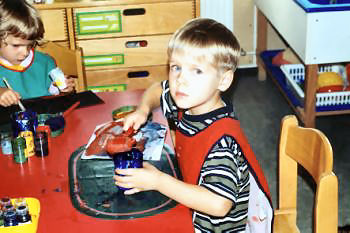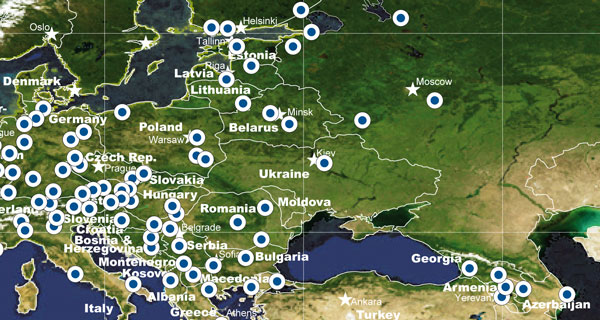Sponsor a Child!

Sponsoring a child in Eastern European countries (Romania, Russia, etc.) through SOS Children could make all the difference between an orphan on the street or suffering in a state orphanage and a former orphan in a loving home.
Background to Child Sponsorship in Eastern Europe
Children in Eastern Europe are at risk from new dangers of HIV/AIDS, greater use of drugs and increasing child trafficking. Increasing poverty and a fall in spending on social programmes means that more and more children in Eastern Europe are excluded from the benefits of economic progress. Often it is the same groups of children who are most affected - those with HIV/AIDS, ethnic minorities, refugees and, very often, girls.
The incidence of HIV/AIDS in Eastern Europe remains relatively low but the region does have the largest proportion of paediatric AIDS cases following an outbreak of infection among young children in hospitals in Romania around 1990. The incidence of HIV/AIDS, which was previously extremely low, is now increasing rapidly. However, it is likely that the incidence of HIV/AIDS is grossly understated. There are estimated to be about 1.4 million people living with HIV/AIDS, of which 80% are under 30 years old.
Defining the geographical area that is Eastern Europe is usually meant to include those countries that were once part of the Soviet bloc and/or members of the Warsaw Pact. As the European Union expands, with former members of the Soviet Bloc becoming members of the EU, this definition has less validity. In these pages the countries included are: Albania, Armenia, Azerbaijan, Belarus, Bosnia & Herzegovina, Bulgaria, Croatia, Czech Republic, Estonia, Georgia, Hungary, Kosovo, Latvia, Lithuania, Macedonia, Poland, Romania, Russia, Serbia and Ukraine. In all these countries there are many orphaned and vulnerable child in need of sponsorship.
Recent developments for Children in Eastern Europe

Following the collapse of the communist system in the 1990s, expectations were high that institutional childcare would be reformed. Images of children in large orphanages put pressure on governments and NGOs to change the system and to replace it with alternative forms of child care that were more family-centred. However, according to some estimates, there are today over one million children living in institutions – government-run orphanages and boarding schools – which fail to meet even the minimum standards expected by the UN Convention on the Rights of the Child. This convention has been ratified by all countries in the region. It is past the point where we can sit by and watch governments fail their children: we have a responsibility to help them too!
Many of the, now independent, countries are finding it difficult to raise the level of economic activity and standards of welfare to those that existed before 1990. Economic liberalisation has had a negative affect on children and families in the region – an increase in family breakdown has resulted in an increase in the number of single-parent families, who find it more and more difficult to care for their children on their own. Children are being placed in so-called orphanages even though many of the children are in fact not orphans. Generally speaking, if the natural family is unable to care for their own children, their first choice is still institutional care. Once children have been placed in such institutions, contact with their natural family is often non-existent. There has been a huge gap in the understanding of the alternatives.
SOS Children has been working in the region since 1970 when the first SOS Children’s Village opened in what was then Czechoslovakia. Before the collapse of the communist system, SOS Children was also working in Hungary, Poland and the former Yugoslavia. Today SOS Children works in 20 countries and territories in the region, providing childcare based on the family, as an alternative to institutionalised child care. As well as traditional SOS Children’s Villages, SOS Children has developed and is developing “Family Strengthening Programmes” that give support to children and their families within the local community in order to prevent abandonment. In many countries in the region, SOS Children and other NGOs are working together committed to the interests of the children. The focus is on supporting families so that children are not separated from their natural families and thus removing the need for institutional children’s homes.
Children: The early years
Every year around 250,000 children in Eastern Europe die before their third birthday as a result of preventable disease and malnutrition. Many more live with chronic physical or mental disability. These deaths and illnesses could be prevented if parents had the right information and the right support to help them care for their children.
- Infant death rate in Eastern Europe is at least ten times higher than in West Europe.
- 10% of children have some disability, often caused by poor care and nutrition in the early years.
- More babies are being born to HIV positive mothers.
- More infants live in institutions.
Children: School
Education in Eastern Europe faces many challenges – for example, schools that have no heating and not enough text books. In addition family poverty stops children, particularly girls, from going to school. Outside school, many children are exploited, abused or neglected. More and more live in institutions, separated from their families and many have been driven from their homes by war.
- At the end of the 20th century, almost 18 million children were living in poverty - on less than £1.20 per day.
- Spending on education fell by 75% in the 1990s.
- Over 2 million people – most of them women and children – are refugees or internally displaced.
- More and more children live and work on the streets. All face discrimination and violence. All are vulnerable to sexual exploitation.
Young people in Eastern Europe have new opportunities as the restrictions their parents faced lessen. They also face new risks, including one of the steepest increases in the spread of HIV/AIDS. In 2004 there were an estimated 1.4 million people living with HIV across the region – a 40% increase since 2002 – of which more than 80% are under 30 years old. Young people also face poverty, unemployment, trafficking in drugs and human beings, and violence – all of which feed the HIV epidemic.
SOS Children in Eastern Europe
SOS Children has been working in Eastern Europe since 1970, when the first SOS Children’s Village opened in what was then Czechoslovakia. Today SOS Children works in 20 countries in Eastern Europe, caring for children who have nothing and no one and for vulnerable children whose parents, for what ever reason, are not able to care for them. More and more of the work focuses on so called Family Strengthening Programmes which are designed to help prevent the abandonment of children. Since 1970 SOS Children has developed projects and programmes in 20 countries from Albania to Ukraine directly caring for over 3,000 orphaned, abandoned or vulnerable children and supporting nearly 60,000 vulnerable children and their families in the local communities.

 Return to Schools Wikipedia Home page…
Return to Schools Wikipedia Home page…
